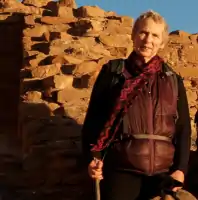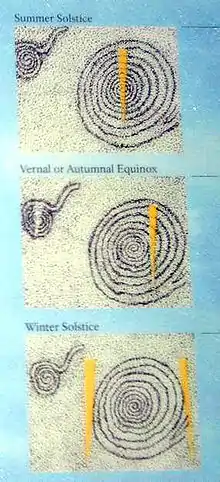Anna Sofaer
Anna Sofaer (born November 20, 1940) is an American researcher and educator on the archaeoastronomy of the Ancestral Puebloans of the American Southwest and other ancient cultures. In 1977, she "rediscovered" the astronomical marker site known as the Sun Dagger on Fajada Butte in Chaco Culture National Historical Park. Research has indicated this site records the solar and lunar cycles.

In 1978, she founded the non-profit Solstice Project, through which she has produced a book of peer-reviewed research papers and two documentary, PBS broadcast films on Chaco Canyon. She continues to produce research and films from Santa Fe, New Mexico, where the Solstice Project is based.
Life and education
Sofaer was born on November 20, 1940 in Philadelphia, PA, where she grew up. She graduated from Sarah Lawrence College in 1962, where she met scholar of mythology Joseph Campbell. He became a research adviser when she founded the Solstice Project. Working previously in social planning, community organization, housing opportunity initiatives, and as an artist, she developed an interest in Maya astronomy, leading to her documentation of Southwestern pictographs and petroglyphs.[1]
She married Michael Pertschuk in 1977.
Solstice Project
Rediscovery of the Sun Dagger

In 1977 Sofaer visited Chaco Canyon as a volunteer recording ancient Southwestern American rock art. She chanced to record petroglyphs on Fajada Butte at what is now called the Sun Dagger or Three Slab site, now perhaps the most famous site in Chaco Canyon, located at a southeastern facing cliff near the top of Fajada Butte. The three large stone slabs leaning against the cliff channeled light and cast shadow so as to create light "dagger" markings on two spiral petroglyphs on the cliff wall. "We happened to get there near noon, a week from solstice, and a dagger of light was bisecting the spiral."[2] Her research has since indicated this site to likely have been a calendrical shrine, marking the sun's varying heights at solstices and equinoxes, and the moon's rise over its 18.6 year standstill cycle.[1]
Research and films

In 1978, Sofaer founded the 501(c) organization Solstice Project. The purposes of the organization are research, preservation, and education regarding the ancient Chaco culture of the Four Corners region.[3] The Solstice Project's research initially focused on the Sun Dagger site, with research collaborators including physicist Rolf Sinclair (NSF), astronomer LeRoy Doggett (USNO), architect Volker Zinser,[4] archaeologist R. Gwinn Vivian,[5] and anthropologist and MacArthur Fellow, Alfonso Ortiz of the Tewa Ohkay Owingeh, New Mexico Pueblo. The Solstice Project expanded its studies to include surveys, in collaboration with Phillip Tuwaletstiwa and other geodesists of the NGS of NOAA, of the orientations of the Chacoan Great Houses and the Great North Road. In 2008, Sofaer's peer-reviewed research papers to date were compiled and published as Chaco Astronomy: An Ancient American Cosmology,[6] by Ocean Tree Books.
Some archaeologists were initially skeptical of the role of the moon in ancient monuments[7] but Sofaer's work in general has been met with praise from such groups as the American Association for the Advancement of Science,[8] National Geographic, archaeologists such as Timothy Pauketat and Stephen Lekson[9] and the American Southwest's Native American communities. Her research has also been presented in astronomy textbooks and encyclopedias[10]
The Solstice Project's films to date are The Sun Dagger (1982) and The Mystery of Chaco Canyon (1999),[11] both narrated by Robert Redford and broadcast by PBS.
Awards and recognition
As well as being featured in books for children,[12] Sofaer was ceremonially recognized with a day of honor by her hometown of Santa Fe, New Mexico.
References
- Sofaer, Anna (2008), Chaco Astronomy: An Ancient American Cosmology, Ocean Tree Books, ISBN 978-0-94373-446-0
- "Interview with Anna Sofaer" (PDF). Archived from the original (PDF) on 2011-09-29. Retrieved 2016-02-21.
- "The Solstice Project - About Us".
- "LeRoy E. Doggett Prize for Historical Astronomy". Archived from the original on 2016-03-03.
- "SAR—R. Gwinn Vivian".
- Sofaer, Anna (2008). Chaco Astronomy. ISBN 9780943734460.
- Aveni, Anthony (1993), Ancient Astronomers, St. Remy Press, p 128.
- "EXPLORING SCIENCE AND RELIGIONS". The New York Times. 16 July 1982.
- "Steve Lekson". Archived from the original on 2016-03-27.
- Pasachoff, Jay M (1987). Astronomy: From the Earth to the Universe. ed. 3, etc., Saunders College Publishing. pp. 28-30.
- Kenneth Eagle Spirit (31 March 2007). "The Mystery of Chaco Canyon (TV Movie 1999)". IMDb.
- Thimmesh, Catherine (2002). The Sky's the Limit: Stories of Discovery by Women and Girls, Houghton Mifflin, ISBN 0-61807-698-0
- References:
- Ford, D. (1993), "Appendix H" of The Spadefoot Toad Site: Investigations at 29SJ 629 Chaco Canyon, New Mexico Volume I, by Thomas C. Windes, Reports of the Chaco Center, Number 12, Branch of Cultural Research, Division of Anthropology, National Park Service, Santa Fe, New Mexico.
- Sofaer, Anna (2008), Chaco Astronomy: An Ancient American Cosmology, Ocean Tree Books, ISBN 978-0-94373-446-0
- Sofaer, Anna, dir., Robert Redford, narr., “The Mystery of Chaco Canyon” (PBS; Bullfrog Films, 1999).